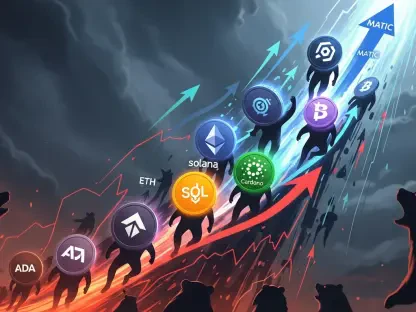Imagine a financial chessboard where billions of euros in frozen assets could tip the balance of a geopolitical struggle, and the European Union (EU) faces a pressing dilemma on how to leverage approximately 140 billion euros of immobilized Russian central bank funds to support Ukraine without triggering legal, security, or diplomatic fallout. This roundup dives into diverse opinions and insights from policymakers, legal experts, and geopolitical analysts across the region. The purpose is to unpack the complexities of this high-stakes proposal, compare contrasting viewpoints on risk-sharing, and explore potential paths forward as Belgium urges collective responsibility among EU member states.
Exploring the Proposal to Fund Ukraine
The Financial Innovation at Play
Across various discussions, there’s a shared recognition of the urgency to support Ukraine, especially as external military aid from other allies wanes and national budgets within the EU tighten. Many policymakers advocate for a creative loan mechanism, using the frozen Russian assets as collateral tied to future reparations. This approach aims to bypass the legal barrier of outright confiscation, which is prohibited under international law, while providing immediate financial relief to Ukraine for military and operational needs in the coming years.
Differing views emerge on the feasibility of this plan. Some financial strategists highlight the ingenuity of front-loading reparations into a loan structure, suggesting it could set a precedent for economic tools in conflict resolution. Others, however, caution that the complexity of implementation, combined with a lack of clarity on repayment timelines, might undermine the initiative’s effectiveness, leaving Ukraine in a precarious position if reparations are delayed or disputed.
Belgium’s Central Role and Concerns
Belgium, as the primary holder of these assets through the Euroclear securities depository, finds itself in a uniquely vulnerable spot, managing around 185 billion euros of the total frozen funds. Insights from regional leaders emphasize Belgium’s push for a unified EU stance, with calls for all member states to sign a commitment to share potential risks. The fear of Russian retaliation—whether through financial countermeasures or direct threats—looms large, shaping the narrative of a disproportionate burden on a single nation.
Contrasting opinions surface on how this vulnerability should be addressed. Certain analysts argue that Belgium’s exposure necessitates a robust EU-wide risk-sharing framework to prevent unilateral fallout. Meanwhile, others believe that Belgium, given its role as a financial hub, must accept some level of inherent risk, though they acknowledge the need for enhanced security measures for key personnel involved in managing these assets.
Legal and Geopolitical Challenges
Navigating International Law Constraints
Legal experts across the board agree that the prohibition on seizing sovereign assets under international law poses a significant hurdle. The consensus leans toward crafting a workaround that respects Russia’s claim to the funds while enabling their temporary use. Discussions often center on the European Commission’s framework, which seeks to balance legality with action, though unresolved issues persist regarding the long-term implications of such a move.
Divergent perspectives arise on the potential precedent this could set. Some legal scholars warn that even a loan-based approach might erode global financial norms, inviting challenges from other nations in future disputes. On the flip side, proponents argue that the exceptional circumstances of the Ukraine conflict justify bending traditional rules, provided the mechanism is transparent and narrowly tailored to avoid broader misuse.
Internal EU Divisions on Risk-Sharing
Within the EU, opinions on mutualizing risk are sharply divided. Many leaders from member states supportive of Ukraine endorse Belgium’s call for collective accountability, viewing it as a test of EU solidarity. They argue that shared responsibility would not only protect individual nations from retaliation but also strengthen the bloc’s unified stance against Russian aggression.
However, skepticism persists among other national voices, with some rejecting the idea of mutualized risk due to domestic fiscal constraints or fears of legal repercussions. Analysts point out that these fractures could stall the proposal, highlighting how varying national interests—from economic priorities to geopolitical alignments—complicate consensus. The debate underscores a deeper tension between unity and self-preservation within the union.
Russia’s Reaction and Global Implications
Geopolitical observers widely note Russia’s strong condemnation of the EU’s plan, labeling it as outright theft and threatening reciprocal actions. This hostile rhetoric fuels concerns about escalating tensions, with some analysts predicting that Moscow’s promised harsh response could extend beyond financial measures to broader diplomatic or even cyber confrontations.
On the global stage, perspectives vary on how to coordinate a response. Advocates for international collaboration, including input from the G7, stress the importance of aligning strategies across nations holding frozen Russian assets, such as the U.S. and Japan. Critics, however, question whether such coordination is feasible given the lack of transparency on asset locations and differing legal frameworks, suggesting that fragmented approaches might weaken the overall impact.
Practical Insights and Strategies
Building a Framework for Collaboration
A range of strategic thinkers propose actionable steps to move forward, emphasizing the need for a clear risk-sharing agreement among EU states. Suggestions include formalizing commitments through binding resolutions at upcoming summits, ensuring that no single country bears the brunt of potential fallout. This approach, many argue, could rebuild trust among member states hesitant to engage.
Additionally, enhancing transparency about the distribution and value of frozen assets globally is seen as critical. Financial experts recommend creating a centralized database accessible to all involved parties to facilitate coordination and reduce misunderstandings. Such measures could also help in aligning military spending plans for Ukraine, ensuring funds are allocated efficiently.
Monitoring Broader Impacts
Analysts also urge close attention to the ripple effects of this financial strategy on economic warfare tactics. Some suggest that success in this endeavor might redefine how sanctions and asset freezes are wielded in future conflicts, offering a blueprint for Western nations. Others caution against over-optimism, pointing out that missteps could provoke unintended escalations with far-reaching consequences.
A recurring tip is to prioritize dialogue over unilateral action, both within the EU and with international partners. Engaging in continuous negotiations, particularly at high-level meetings, is viewed as essential to iron out legal ambiguities and geopolitical concerns. This collaborative spirit, many believe, could ultimately determine the plan’s viability.
Reflecting on a Divisive Yet Pivotal Debate
Looking back, the discussions surrounding the use of frozen Russian assets to aid Ukraine revealed a landscape of cautious ambition marred by deep divisions. The insights gathered from policymakers, legal minds, and geopolitical analysts painted a picture of an EU grappling with innovation under pressure. While Belgium’s plea for shared risk resonated with many, the resistance from certain member states and Russia’s fierce opposition underscored the fragility of consensus. Moving forward, the focus should shift to crafting detailed, binding agreements on risk distribution and transparency at future EU summits. Exploring parallel strategies, such as bolstering non-financial support for Ukraine, could also alleviate pressure on this contentious plan. As this debate continues to unfold, stakeholders are encouraged to delve into detailed policy briefs and summit outcomes for deeper understanding and to stay engaged with evolving solutions.









